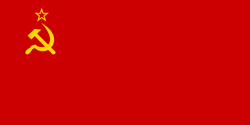
The flag of the USSR.
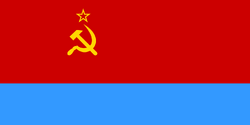
The flag of Ukraine SSR.
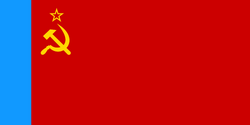
Russian FSR flag.
Stats

The flag of the USSR.
- Name-Russian: Союз Советских Социалистических Республик (CCCP). English: Union of Soviet Socialist Republics\Soviet Union (USSR).
*Continent = Europe and Asia.
- Existed between = 1922-1991.
- Population = 293,047,571 (1991).
- Capital city= Moscow
- Currency- Soviet ruble (SUR).
- Fiscal year- 1 January – 31 December (calendar year).
- Trade organisations- Comecon, ESCAP and others.
- GDP-$820 billion in 1977 (Nominal; 2nd), $1.212 trillion in 1980 (Nominal; 2nd), $1.57 trillion in 1982 (Nominal; 2nd), $2.2 trillion in 1985 (Nominal; 2nd) and $2.6595 trillion (1989 est.) (PPP; 2nd).
- GDP per capita- $5,800 (1982 est.) (Nominal; 32nd) and $9,130 (1991 est.) (PPP; 33rd).
- GDP by sector- agriculture: (1–2%, 1991), industry: (–2.4%, 1991)(1991 est.).
- Inflation (CPI)- 14% (43rd) (1991).
- Labour force- 152.3 million (3rd) (1989 est.).
- Labour force by occupation- 80% in industry and other non-agricultural sectors; 20% in agriculture; shortage of skilled labor (1989 est.).
- Unemployment 1–2%.
- Main industries- petroleum, steel, motor vehicles, aerospace, telecommunications, chemicals, heavy industries, electronics, food processing, lumber, mining, and the defense (1989 est.).
- Defence organisation: Warsaw Pact.
- National global power ranking: Super-power.
- Nucliar, chemical and biological (NBC) arms: Yes for all.
Overview
The Soviet Union, officially the Union of Soviet Socialist Republics (USSR) was a socialist country that existed in Eurasia from 1922 until 1991. In 1991, it was dissolved into 15 different countries.
Сове́тских Социалисти́ческих Респу́блик, tr. Soyuz Sovetskikh Sotsialisticheskikh Respublik; IPA: [sɐˈjus sɐˈvʲɛtskʲɪx sətsɨəlʲɪsˈtʲitɕɪskʲɪx rʲɪˈspublʲɪk] abbreviated to USSR (Russian: СССР, tr. SSSR) or shortened to the Soviet Union (Russian: Сове́тский Сою́з, tr. Sovetskij Soyuz; IPA: [sɐ'vʲetskʲɪj sɐˈjʉs]), was a Marxist–Leninist state on the Eurasian continent that existed between 1922 and 1991. A union of multiple subnational Soviet republics, its government and economy were highly centralized. The Soviet Union was a one-party state, governed by the Communist Party (CPSU) with Moscow as its capital.
The Soviet Union (Russian: Советский Союз, romanized as- Sovietsky Soyuz), officially the Union of Soviet Socialist Republics (USSR or U.S.S.R; Russian: Сою́з Сове́тских Социалисти́ческих Респу́блик, romanized as- Soyuz Sovietskikh Sotsialisticheskikh Respublik) was a Communist country spanning the European and Asian continents, from the Baltic and Black seas in the West to the Okhotsk sea in the East and the Caspian Sea to the south.
Soviet Union has an area of 8,649,538 sq mi (22,402,200 km2) and a population of 293,047,571. The average density is caculated to be ~ 33.9 /sq mi (13.9/km2).
It consisted of 15 Soviet Socialist Republics (soyuznye respubliki) from 1956 until its end. Its government and economy was highly centralised.
History
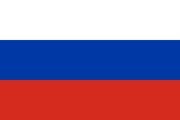
The Russian flag.

The Flag of the Lithuanian-Byelorussian SSR (AKA- Lit-Bel).
The Soviet Union's national flag

The Russian flag.
After defeating the Provisional Government of Russia, anarchists, cossaks, Mechavicks and anti-communists; the Bolsheviks unified the Russian, Byelorussian, Irkusk, Amur, Ukrainian, Bukhara and Transcaucasian SSRs.
After Lenin had died, Stalin struggled with his political rivals to come to power and started a rapid state planned industrialisation of the country.
After Stalin's death in 1953, the Soviet Union went under a process of de-Stalinization under Nikita Khrushchev, and achieved many notable successes.
After Nikita Khrushchev was removed from office, due to a reform that introduced collective leadership, subsequent leaders (Leonid Brezhnev, Yuri Andropov, Konstantin Chernenko) did not have much power, and when Mikhail Gorbachev acceded to the position, the Soviet Union has already falling into a crisis.
He tried to reform politics and the economy, but faced opposition from both the people and the party. Yet, he created the opportunity for the republics to proclaim independence, and the Soviet Union eventually fell under the leadership of Vladimir Ivashko.
The Lenin era
After taking over Russia and forming the USSR they began to spread communism, in to neighboring states. The Bolsheviks helped in the creation of the short lived Braverian-Munich SSR of 1919 and the long term take over of Mongolia by communists in 1924.
Both Bukhora (mostly in today's Uzbekistan) and Tanu Tuva (in Siberia directly north west of Mongolia) became communist states under Bolshevik influence in the early 1920's as well. Bukhara soon joins the USSR.
The Stalin era
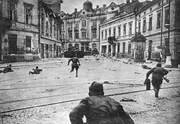
Lvov–Sandomierz Offensive- Soviet Soldiers in Lvivh, 13 July 1944 – 29 August 1944. The great clash of Communism over Nazism. Hungary, SS Galitzen fought on this front. Nazi Germany lost to the USSR. Both Germany and the USSR were traumatized for many years a afterwards.
Field Marshal Joseph Stalin sign the Molotov - Ribbentrop Pact which led to occupation of Western Poland (now part of Belarus and Ukraine), the Baltic states, some Romanian districts and Finland’s the Karelian province. The locals either fled abroad, slavishly obeyed government orders or were moved to Gulag prison and/or labour concentration camps.
The USSR fought a bloody war with Nazi Germany after the Nazis invaded the USSR in 1941. The Great Patriotic War of 1941-1945 as the Soviets and now successor states call it, killed about 25,000,000 Soviets, 3,000,000 Germans, 250,000 Romanians and 150,000 Hungarians by it's end. The USSR was so traumatised and fearful that it thought only the occupation of neighboring states like Poland and treating penitential threats like the USA was the only way could their stop a new invasion of the nation. The Baltic states were formally annexed to the USSR to Anglo-French disgust.
Tannu Tuva SSR joined the USSR in 1944.
Between 1945 and 1948, communist governments were set up as puppet and client regimes in Hungary, Bulgaria, Romania, Czechoslovakia, Poland, East Germany (Yugoslavia and Albania already got an interim communist government before the war's end). Stalin, who was clinically paranoid by this time, finally died in 1953.
Bulganin era
The Soviets retained garrison troops throughout the territories they had occupied. During The Cold War saw these states formed the Warsaw Pact and Commecon, have continuing political and military tensions with the capitalist NATO bloc, in a 50 year stand-off in Europe.
Khrushchev era
Khrushchev took power and start simultaneous reforms. However, the big loss in war didn't seem to have been fully reverted, and economic poorness began to swallow the nation. Many projects worked well, but others were major flops. In the Hungarian Revolution of 1956, a spontaneous nationwide pro-democracy revolt had occurred and the Soviet Union invaded Hungary to re-assert its control.
Brezhnev era
In 1968, the USSR repressed the pro-democracy Prague Spring by organizing the Warsaw Pact invasion of Czechoslovakia. Détente then occurred in several East-West summits between Brezhnev and America's president Nixon. A add-mixture of corruption, fear, incompetence, government dictates, wastefulness and in inefficacy gradually undermined the Soviet state from within after the mid 1970's.
By the early 1980s the declining Soviet economy got a big hit, thus affecting the whole block. In Poland, more than 60% of population lived in poverty, and inflation, measured by black-market rate of the U.S. dollar, was 1,500% in the period 1982 – 1987. Poland later became the cradle of the Revolutions of 1989.
Andropov era
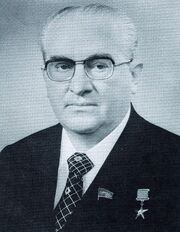
Premier Yuri Andopov.
Due to a then political protocol, this successor of Brezhnev were obliged to rule in the same way as Brezhnev did. Therefore, hey did not left much influence. He died of old age after a about a year in office. The Poles were told to destroy the growing opposition block within Poland or face a Soviet take over of the nation.
Chernenko era
Due to a then political protocol, this successor of Brezhnev were obliged to rule in the same way as Brezhnev did. Therefore, he did not left much influence. He died of old age after a about a year in office. Relations began to improve with NATO, but collapsed with China, N. Korea and Poland.
Gorbachev era
Mikhail Gorbachev was elected General Secretary by the Politburo on March 11, 1985, only three hours after Konstantin Chernenko's death. Upon his accession at age 54, he was the youngest member of the Politburo. Gorbachev's primary goal as General Secretary was to revive the Soviet economy after the stagnant Brezhnev years.
Gorbachev's policies of perestroika and glasnost in the late 1980's helped end the cold war, introduced a free market economy and significantly expanded freedom of expression in both the media and the press. As this happened supplies started to run out, inflation grew and fighting started between both Armenia and Azerbaijan.
The 1991 Soviet coup d'état attempt, also known as the August Putsch or August Coup was a rebellion by Viktor Yanayev and a few hard liners in the Soviet communist party. The ruling GKChP cabal included Viktor Yanayev, Gen. Pavlov, Mr Kryuchkov, Mr Yazov, Boris Pugo (head of the KGB), Oleg Baklanov, Vasily Starodubtsev (chairman of the USSR Peasant Union), and Alexander Tizyakov (president of the Association of the State Enterprises and Conglomerates of Industry, Transport, and Communications).
Mikhail Gorbachev gave up leadership in late 1991 and Vladimir Ivashko finally took over most leadership roles for a few more days. Boris Yeltsin soon became president, and later on, the first democratically elected President of Russia.
Ethnic and cultural groups
Ethnic problems
The economy of the Soviet Union
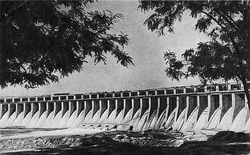
DneproGES hydro-electric power plant in Ukraine is one of the symbols of Soviet economic power, was completed in 1932.
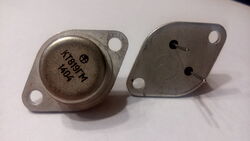
A КТ819ГМ NPN power transistor (Soviet 2N3055 copy) in TO-3 package.
The economy of the Soviet Union was based on a system of state ownership of the means of production, collective farming, industrial manufacturing and centralized administrative planning. The economy was characterised by state control of investment, public ownership of industrial assets, macroeconomic stability, negligible unemployment and high job security.
Beginning in 1928, the entire course of the economy was guided by a series of Five-Year Plans. By the 1950s, the Soviet Union had, during the preceding few decades, evolved from a mainly agrarian society into a major industrial power. Its transformative capacity—what the US National Security Council described as a "proven ability to carry backward countries speedily through the crisis of modernization and industrialization"—meant communism consistently appealed to the intellectuals of developing countries in Asia. Impressive growth rates during the first three Five-Year Plans (1928–40) are particularly notable given that this period is nearly congruent with the Great Depression. Nevertheless, the impoverished base upon which the Five-Year Plans sought to build meant that, at the commencement of Operation Barbarossa, the country was still poor. While legitimate strictly in terms of growth and industrialisation, the death toll attributable to Stalinist economic development has been estimated at 10 million, much of which comprises famine victims.
The major strength of the Soviet economy was its enormous supply of oil and gas, which became much more valuable as exports after the world price of oil skyrocketed in the 1970s. As Daniel Yergin notes, the Soviet economy in its final decades was "heavily dependent on vast natural resources–oil and gas in particular." However, Yergin goes on, world oil prices collapsed in 1986, putting very heavy pressure on the economy. After Mikhail Gorbachev came to power in 1985, he began a process of economic liberalisation that moved the economy towards a market-oriented socialist economy. At its dissolution at the end of 1991, the Soviet Union begat a Russian Federation with a growing pile of $66 billion in external debt, and with barely a few billion dollars in net gold and foreign exchange reserves.
The complex demands of the modern economy and inflexible administration overwhelmed and constrained the central planners. Corruption and data fiddling became common practice among the bureaucracy by reporting fulfilled targets and quotas, thus entrenching the crisis. From the Stalin-era to the early Brezhnev-era, the Soviet economy grew much slower than Japan and slightly faster than the United States. GDP levels in 1950 (in billion 1990 dollars) were 510 (100%) in the USSR, 161 (100%) in Japan and 1456 (100%) in the US. By 1965 the corresponding values were 1011 (198%), 587 (365%), and 2607 (179%). The Soviet Union maintained itself as the second largest economy in both nominal and purchasing power parity values for much of the Cold War until 1988, when Japan's economy exceeded $3 trillion in nominal value.
The USSR's relatively small consumer sector accounted for just under 60% of the country's GDP in 1990, while the industrial and agricultural sectors contributed 22% and 20% respectively in 1991. Agriculture was the predominant occupation in the USSR before the massive industrialization under Joseph Stalin. The service sector was of low importance in the USSR, with the majority of the labor force employed in the industrial sector. The labor force totaled 152.3 million people. Major industrial products included petroleum, steel, motor vehicles, aerospace, telecommunications, chemicals, electronics, food processing, lumber, mining, and defense industry.
Though, the GDP of the USSR crossed $1 trillion in the 1970s and $2 trillion in the 1980s, the effects of central planning were progressively distorted due to the rapid growth of the second economy in the Soviet Union.
Economic problems
Endemic corruption ripped the economy apart after the mid 1970s. The Shadow economy, poverty, and the smuggling of cars on fishing boats from Scotland and Japan helped ruing the plans of the now haplessly\hopeless out of touch bureaucrats working for the Politburo!
Gulags and the KGB
Space and science achievements
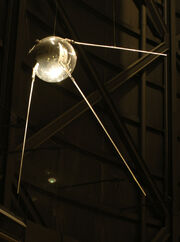
Sputnik.
Agricultural issues
.
Religion
Officially the USSR was atheist and hated religion, which it considered bunkum and pseudoscience.
Unofficially, the power hungry and Russia-centric Russian Orthodox Church maintained a fairly close relationship with the ethnically Slavic part of non-atheist factions of the Communist Party.
The Ukrainian Catholic Church, which was at least in part Ukrainian nationalist in nature, was vigorously suppressed in Soviet-controlled Ukraine until 1989. Islam was similarly crushed in Central Asia and Azerbaijan during this time. Lucky, the Buddhist and pagan minorities in Siberia were largely ignored and considered harmless in polito-religious issues.
Defence policy
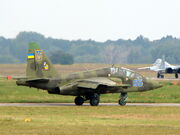
A Su-25UB and MiG-29 (9-13) of Ukrainian Air Force.
Foreign policy

The Cuban flag.
Also see
- Vladimir Lenin
- Kiev TV Tower
- Ostankino Tower
- Tallinn TV Tower (Tallinna teletorn)
- Riga Radio and TV Tower
- Russian and Soviet Leaders since 1917
- Narva Oil Plant
- Estonian oil shale industry
- Narva Power Plants
- The "Baltic Chain" demonstration on August 23, 1989
- Stalin's purges
- Stalin's cult of personality
- Stalinism
- Stalin Monument (Budapest)
- Russia
- Cold War radio propaganda
- Life under communism
- Baltic Way
- Cold War radio jamming
- Baltics are Waking Up
- Singing Revolution
- Life under communism
- The anti-communist "Revolutions of 1989"
- Soviet/NATO invasion of Finland
- The southern Danube route
- Finnish pseudo-neutrality
- Dissolution of the Soviet Union
- Republics of the Soviet Union
- GDR
- GRU
- KGB
- Sputnik
- Vostok 1
- Baikonur Cosmodrome
- A political diorama
- Soviet Space Program
- Radio Moscow
- Science
- Aircraft
- Organisations
- Terrorism
- Soviet Nomenklatura
- Soviet "Era of Stagnation"
- Soviet Ice Breaker Lenin
- Space rockets
- Manned space travel
- Space Satellites
- Opytnoye Konstruktorskoye Buros (OKBs)
- Ballistic missiles, missiles and military rockets
- For an interesting alternate history, see: http://central-victory.wikia.com/wiki/Reichskommissariat_Moskowien, http://thekristoffersuniverseinwar.wikia.com/wiki/Alma-Ata,_Kazakh_Soviet_Socialist_Republic,_Soviet_Union, http://novum-terram.wikia.com/wiki/Soviet_Union, http://central-victory.wikia.com/wiki/Soviet_Union_(1922–1942), http://thekristoffersuniverseinwar.wikia.com/wiki/Economy_of_the_Union_of_Soviet_Socialist_Republics_of_the_Soviet_Union, http://central-victory.wikia.com/wiki/Russian_Soviet_Federative_Socialist_Republic, http://central-victory.wikia.com/wiki/Soviet_Union_(1942–1991), http://thekristoffersuniverseinwar.wikia.com/wiki/Union_of_Soviet_Sovereign_Republics_of_the_Soviet_Union_(New_Union), http://althistory.wikia.com/wiki/Soviet_Union_(Soviet_Revival), http://althistory.wikia.com/wiki/Soviet_Union_(Soviet_West), http://althistory.wikia.com/wiki/Soviet_Union_(Soviet_Freedom), http://althistory.wikia.com/wiki/A_Soviet_World, http://althistory.wikia.com/wiki/Soviet_Defeat, http://althistory.wikia.com/wiki/Soviet_World, http://althistory.wikia.com/wiki/Soviet_Dominance, http://althistory.wikia.com/wiki/Soviet_Moon, http://althistory.wikia.com/wiki/Soviet_West, http://althistory.wikia.com/wiki/The_Soviet_Dream, http://althistory.wikia.com/wiki/Supreme_Soviet_of_the_Soviet_Union_(New_Union), http://althistory.wikia.com/wiki/Soviets_are_going_Down!_(CYOAH), http://althistory.wikia.com/wiki/Operation_Herkules_(Soviet_Defeat), http://althistory.wikia.com/wiki/Soviet_Union_(The_Bright_Sunshine), http://althistory.wikia.com/wiki/Political_Front_(Soviet_Invasion), http://althistory.wikia.com/wiki/Military_Front_(Soviet_Invasion), http://greatmultiverse.wikia.com/wiki/Union_of_Soviet_Socialist_Republics_(Pol_Universe).
Sources
- https://en.wikipedia.org/wiki/Soviet_Union
- http://www.kushnirs.org/macroeconomics_/en/ussr__gdp.html
- https://en.wikipedia.org/wiki/Economy_of_the_Soviet_Union
- https://en.wikipedia.org/wiki/CCCP_(disambiguation)
- http://soviet.wikia.com/wiki/Soviet_Union
- https://en.oxforddictionaries.com/definition/russian
- https://web.archive.org/web/20120915090942/http://pages.towson.edu/thompson/Courses/Regional/Reference/SovietPhysical.pdf
- http://www.fid.su/su/docs/
- https://en.wikisource.org/wiki/The_Encyclopedia_Americana_(1920)/Soviet
- http://region.adm.nov.ru/pressa.nsf/0c7534916fcf6028c3256b3700243eac/4302e4941fb6a6bfc3256c99004faea5!OpenDocument
- https://www.theguardian.com/commentisfree/2010/dec/20/latvia-debt-economy-europe-austerity